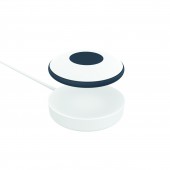Hibu Wearable alert button by Francois Hurtaud |
Home > Winners > #42114 |
 |
|
||||
| DESIGN DETAILS | |||||
| DESIGN NAME: Hibu PRIMARY FUNCTION: Wearable alert button INSPIRATION: Elderly users of electronic devices are a growing market. Designing a wearable alert button for the elderly demonstrated a variety of specific requirements. Research showed that in early versions of alert buttons, mobility and accessibility restrictions caused operational frustration that left many devices to be neglected and unused. There was also a need for the device to react without user input due to various potential emergencies common with the audience such as falling and unconsciousness. UNIQUE PROPERTIES / PROJECT DESCRIPTION: Hibu is paired to a mobile phone via Bluetooth and connects with an app, the phone provides a communication link to dedicated services when Hibu is triggered. Hibu allows a button to be greatly reduced in size, increased in reliability and longevity, and placed in more relevant locations as a wearable. Its minimal size and simple shape is visually acceptable to domestic and professional uses allowing for easy expansion and growth into various markets by simply modifying the dynamics of the app. OPERATION / FLOW / INTERACTION: To use Hibu install the app on an Android device or iPhone, input your relevant data, and pair the device with the app on the phone via Bluetooth. To operate Hibu simply press the textured button, in cases where the user suffers a fall or lapse of unconsciousness Hibu will automatically detect this occurance and provide an alert accordingly. There is a 10 second period within which the trigger can be cancelled by pressing the button at the centre of the screen on the mobile phone when Hibu is triggered. PROJECT DURATION AND LOCATION: Hibu started in 2014 in Holland and finished in March 2015 in Hong Kong. |
PRODUCTION / REALIZATION TECHNOLOGY: Industrial designers worked alongside electronic, mechanical and production engineers to create a device that encapsulates all the components within an ultrasonically sealed waterproof housing (IP67 standard). The overmolded silicon button was mechanically bonded maintaining waterproof functionality. Custom size and shape wireless charging coils and batteries were especially made to maximise internal space, whilst the PCB was reduced to a single layer. SPECIFICATIONS / TECHNICAL PROPERTIES: Hibu device - 47.3mm diameter x 12mm Charging base (not including cable) - 47.3mm diameter x 13mm Operating Temperature: 0°C – 50°C Non-operating Temperature: 10°C – 40°C Relative Humidity: 10% - 90% non-condensing Maximum operating altitude: 3000m Net Weight: Approx. 250g Fall detection: Accelerometer fall detection Vibrate: Alarm feedback by vibration, silent feedback BLE connectivity: Bluetooth 4.0, BLE. Bluetooth Connection Range: 10m, free field Rechargeable Battery: Li-ion Polymer Battery, 2 weeks battery life Wireless charge: Charge in 3 hours, charge dock connected by USB. Battery Level: Battery level feedback on App Mobile App: iOS and Android compatible TAGS: Alert button, wearable security device, Bluetooth-connected, RESEARCH ABSTRACT: From our opinion, the majority of portable alert buttons on the market are not ergonomic, often bulky in feel and look which is why we designed Hibu. Previous iterations created by engineers do not meet nor understand user expectations and therefore created a product that is not market ready. Monitorlinq works closely with hospital and does research with health condition data gathered. Hibu is a leap forward in expanding the business model of monitorlinq. Based on the existing health condition database that owned by monitorlinq, Hibu is designed to provide a more relevant service to their clients. It benefits the end users and helps prevent life risk. CHALLENGE: As health condition data of physically-impaired and elderly varies and mostly remains confidential, we put tremendous effort to gather user data to understand user behaviors. To make a health alert button that is applicable to all our target users, we have also conducted substantial research in terms of the size, the appearance and the operation procedures of the wearable device. For technological challenge, it requires delicate consideration and application to fit all the electrical components in such a small device. In the process of making Hibu waterproof yet rechargeable, several experiments have been conducted until we decided to go for ultrasonic welding techniques to make a complete and seamless seal. ADDED DATE: 2015-07-10 10:27:18 TEAM MEMBERS (9) : Francois Hurtaud, , Frederic Vautard, , Frankie Chan, , James Chu, and Ryan Yeung IMAGE CREDITS: Francois Hurtaud, 2015. PATENTS/COPYRIGHTS: Copyrights belong to Tektos Ecosystems Limited 2015 |
||||
| Visit the following page to learn more: http://ibebot.com/ | |||||
| AWARD DETAILS | |
 |
Hibu Wearable Alert Button by Francois Hurtaud is Winner in Wearable Technologies Design Category, 2015 - 2016.· Read the interview with designer Francois Hurtaud for design Hibu here.· Press Members: Login or Register to request an exclusive interview with Francois Hurtaud. · Click here to register inorder to view the profile and other works by Francois Hurtaud. |
| SOCIAL |
| + Add to Likes / Favorites | Send to My Email | Comment | Testimonials | View Press-Release | Press Kit |
Did you like Francois Hurtaud's Wearable Technology Design?
You will most likely enjoy other award winning wearable technology design as well.
Click here to view more Award Winning Wearable Technology Design.








